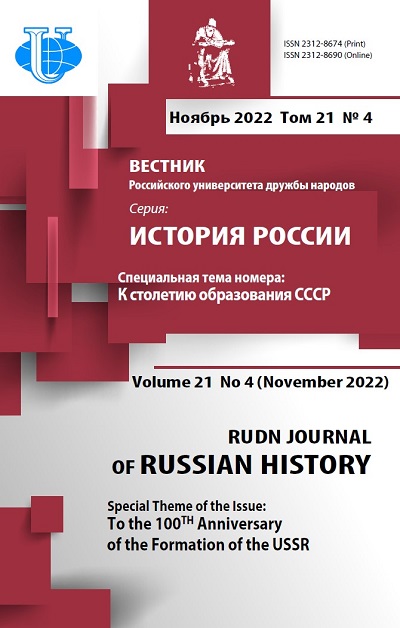Commonly Used Turkic Language in the Declaration and Treaty on the Formation of the USSR
- Authors: Vasilyev A.D.1
-
Affiliations:
- Institute of Oriental Studies of the Russian Academy of Sciences
- Issue: Vol 21, No 4 (2022): To the 100th Anniversary of the Formation of the USSR
- Pages: 469-483
- Section: TO THE 100TH ANNIVERSARY OF THE FORMATION OF THE USSR
- URL: https://journals.rudn.ru/russian-history/article/view/32793
- DOI: https://doi.org/10.22363/2312-8674-2022-21-4-469-483
Cite item
Full text / tables, figures
Abstract
In the article, the author draws parallels between the content of the union treaty on the formation of the USSR and the Soviet language policy of the 1920-1930s. In particular, the “commonly used” Turkic language mentioned in the treaty is considered. The author examines it in the context of the social movement proclaimed by I. Gasprinsky in the late 19th - early 20th centuries for the unity of the Turkic Muslim peoples in their movement towards progress. The pioneers in the development and introduction of the Latin alphabet were representatives of the Azerbaijan SSR, who were among the first to propose such projects of the alphabet reform. Its important element was the unification of the alphabet. In this regard, the author considers the projects for creating a single unified alphabet for the Turkic peoples of the USSR; it was the Azerbaijani version of the Latinized alphabet that was supposed to be the basis for it. This situation gave the leaders of Soviet Azerbaijan the opportunity to lead the process of cultural transformation among the Turkic peoples of the USSR. The article also considers the organizational efforts of the initiators of the idea of latinization to create a unified structure for managing the process of latinization in the USSR, as well as some aspects of their struggle with supporters of a different direction of cultural reforms among the Turks who proposed simplifying the Arabic alphabet.
About the authors
Alexander D. Vasilyev
Institute of Oriental Studies of the Russian Academy of Sciences
Author for correspondence.
Email: advasilyev@mail.ru
ORCID iD: 0000-0003-2947-4413
PhD in History, Senior Researcher of the Center for the Study of Central Asia, the Caucasus and the Ural-Volga region
12, Rozhdestvenka Str., Moscow, 107031, RussiaReferences
- Agazade, F., and Karakashly, K. Ocherk po istorii razvitiia dvizheniia novogo alfavita i ego dostizheniia. Kazan: Gosudarstvennaia Ob"edinennaia tipolitografiia Tatpoligrafa Publ., 1928 (in Russian).
- Akhmedov, T. Nariman Narimanov. Baku: Yazychi Publ., 1988 (in Russian).
- Alpatov, V.M. 150 iazykov i politika, 1917-1997: Sotsiolingvisticheskie problemy SSSR i postsovetskogo prostranstva. Moscow: IOS RAS Publ., 1997 (in Russian).
- Amanzholova, D.A. “Language policy and culture of the Kazakh ASSR managers. 1920-1936.” Rossiiskie regiony: vzgliad v budushchee, no. 2 (2016): 37-60 (in Russian).
- Ashnin, A.D., Alpatov V.M., and Nasilov, D.M. Repressirovannaia tiurkologiia. Moscow: Vostochnaia literatura Publ., 2002 (in Russian).
- Baldauf, Ingeborg. Schriftenreform und Schriftenwechsel bei den Muslimischen Russlandund Sowjetturken (1850-1937). Ein Symptom ideengeschichtlicher und kulturpolitischer Entwicklungen. Budapest: Akad. kiadó Publ., 1993 (in German).
- Bazarova, V.V. Latinizatsiia buriat-mongol'skoi pis'mennosti v 1920-1930 gg. Ulan-Ude: FGOU VPO VSGAKI Publ., 2006 (in Russian).
- Daudov, A.Kh., Malysheva E.P. Iz istorii latinizatsii natsional'nykh alfavitov SSSR, January 1, 2022, http://maxpark.com/community/129/content/2037956 (in Russian).
- Frings, A. “Competition of Models: The Tatar Delegation at the Turkological Congress in Baku in 1926.” Ethnograficheskoe Obozrenie, no. 6 (2005): 44-47 (in Russian).
- Isaev, M.I. Iazykovoe stroitel'stvo v SSSR (protsessy sozdaniia pis'mennostei narodov SSSR). Moscow: Nauka Publ., 1979 (in Russian).
- Kiselev, M.Yu. “Unification of Udmurt Writing: on the History of the Issue.” Historical and cultural heritage of the peoples of the Ural-Volga region, no. 2 (2020): 30-35 (in Russian). https://doi.org/10.15350/26191490.2020.2.4
- Krasovitskaya, T.Yu. “Organizatsiia nauchnoi bazy natsional'no-kul'turnoi politiki v RSFSR (1917-1927.” Velikii Oktiabr' i opyt kul'turnogo stroitel'stva v SSSR. Sbornik statei. Moscow: Institut rossiiskoi istorii Publ., 1987 (in Russian).
- Menzel, Th. “Der 1. Türkologische Kongress in Baku.” Der Islam 16, no. 3-4 (1927): 169-228 (in Russian).
- Mukhametdinov, R.F. Zarozhdenie i evoliutsiia tiurkizma. Kazan: Zaman Publ., 1996 (in Russian).
- Tagiev, I. “Mirza Fatali Akhundov i novyi tiurkskii alfavit.” Kul'tura i pis'mennost' Vostoka, 58-61. Baku: [S. n.], 1928 (in Russian).
- Yusupova, L.A. “Unification of Turkic alphabets. Basic principles of the implementation of the national policy of the Soviet government in relation to the Turks.” Bulletin of Kazan state University of culture and arts, no. 3-2 (2012): 122-123 (in Russian)
- Zmerzly, B.V. Ocherki po istorii pis'mennosti u tiurkskikh narodov. Simferopol: Helvetika Publ., 2014 (in Russian)
















